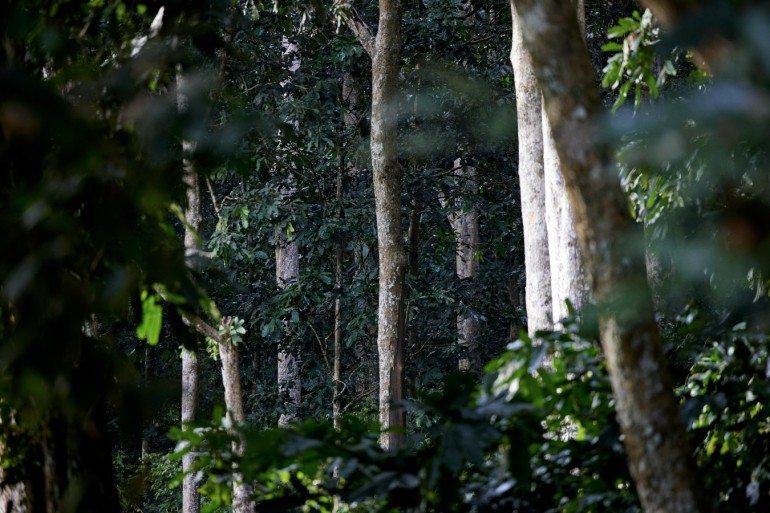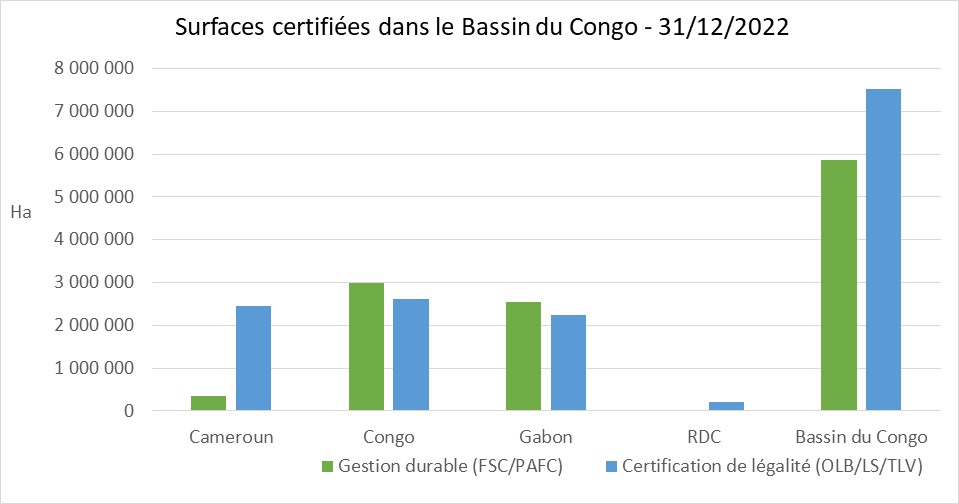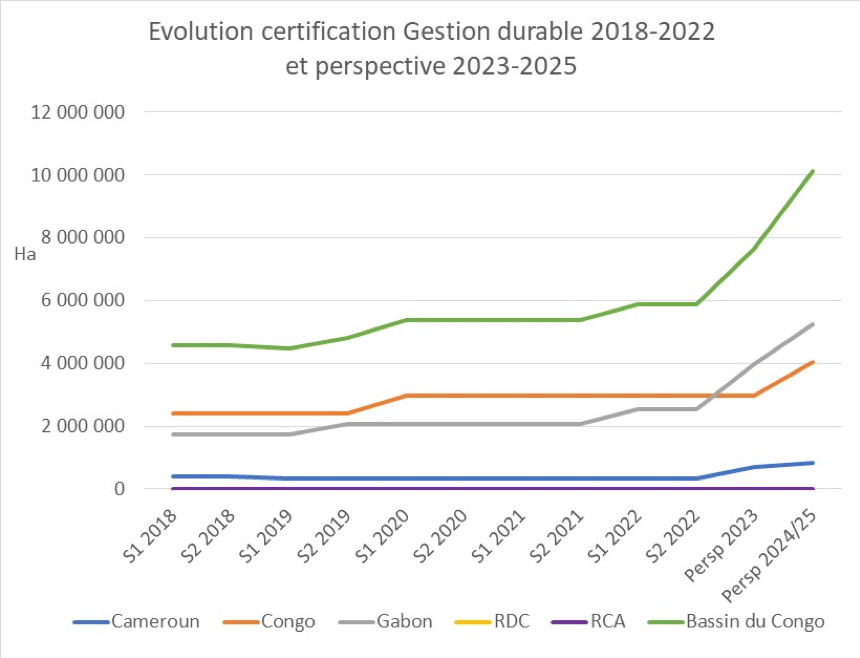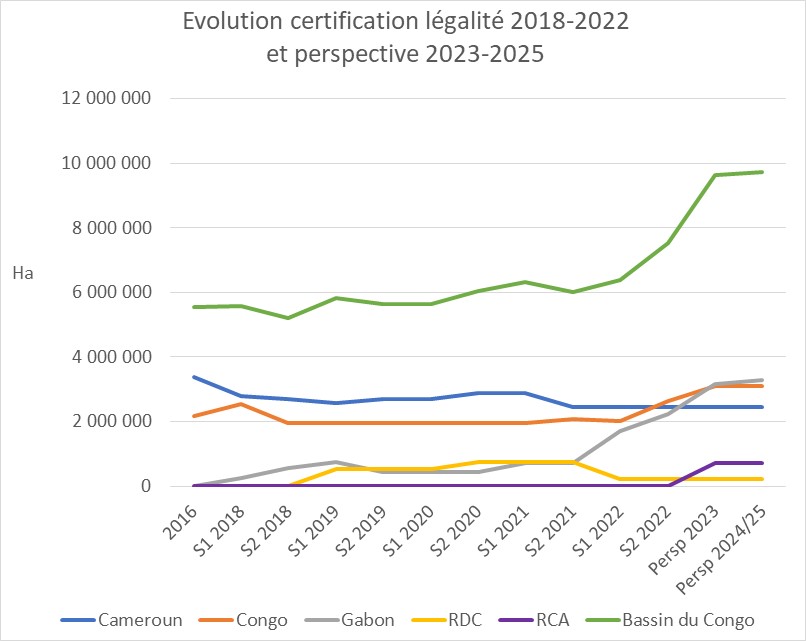

10.02.2023
The threshold of 10 million hectares certified as being under sustainable management should be crossed in 2025, according to the analysis of forest certification data in the Congo Basin carried out by the ATIBT Certification Commission. This is also an opportunity to look at the incentives for certification in the different countries.

At the end of 2022, the Congo Basin had 5,866,756 ha [1] of forest certified as sustainably managed according to FSC and/or PAFC certification (which represents 12% of exploitable forests estimated at 47.5 million ha by OFAC). These certifications are present in 3 countries: Congo (2,989,168 ha), Gabon (2,535,880 ha), and Cameroon (341,708 ha).
Legality certifications (OLB by Bureau Veritas, Legal Source by Preferred by Nature and TLV by Control Union) represent 7,517,616 ha, in 4 countries including Cameroon, Gabon and Congo (about 2.5 million ha per country) and the DRC (205,608 ha).


Sustainable management certification: the second wave is coming
The year 2022 is marked by the issuance of new sustainable management certificates, the first since the first wave in 2000-2010. These are two certificates, one FSC (Gabon Advanded Wood - GAW), the other PAFC Gabon (BSO), issued in Gabon for a total area of 474,690 ha, in accordance with the prospects mentioned last year. The area of sustainably managed forest is thus 5.8 million ha at the end of 2022 (including a concession that is doubly FSC/PAFC certified).
Do these new certificates mark the beginning of a new wave of sustainable management certification? The Congo Basin outlook data[2] collected by ATIBT shows that this could be the case, as it is estimated that an additional 4.2 million ha (for 13 companies) will be gained by 2025, more than half of which will be in Gabon, with the rest in Cameroon and Congo. This would bring the area of sustainably managed forests to 10 million ha, or 73% more.
This second wave can be explained by three main factors:
The implementation of the European Union's new zero deforestation regulation (EUDR), expected in early 2025, will also have an impact on this dynamic, as certification is considered a tool to analyze and reduce the risk of illegality and deforestation/forest degradation.

Legal certification: some slowdown observed
Legally certified areas increased by 13% with a net gain of 917,979 ha in 2022. More than 1.5 million ha have been legally certified in Gabon, while a certificate for more than 500,000 ha has been withdrawn in the DRC.
The outlook for 2025 shows an increase of 2.2 million ha, which would bring the legally certified area to 9,137,970 ha.
This slowdown in legal certification is undoubtedly explained by the end of the first wave of companies interested and concerned by the process. It also reflects the status of certification as a step towards sustainable management certification and the effect of regulatory and institutional levers in favor of sustainable management.

What is the effect of incentives at the national level?
These results also raise questions about the effects of the various incentives for certification that exist in the Congo Basin, which can be direct or indirect:
Fiscal incentives: this involves setting up fiscal incentives for independent third-party certification. Forest tax rates can be modulated based on whether a forestry company has obtained certification and the type of certification. In 2020, Gabon adopted a measure in its finance law that distinguishes between three rates for the area tax: 1) the most favorable rate for concessions with certified sustainable forest management (25% reduction); 2) an intermediate rate, for concessions with a certificate of legality (50% increase); and 3) the highest rate, for concessions without any certification (100% increase. The weight of the area tax in the overall tax burden is not high, however, and the next step would be to also adjust the harvesting and export taxes in the same way (see Karsenty, A. 2021. Incitations fiscales et non fiscales à la gestion durable des forêts: Synthèse des enseignements tirés d’études de cas menées au Brésil, au Cambodge, au Congo, en Côte d’Ivoire, au Myanmar, au Pérou, en Thaïlande et au Viet Nam. Série Technique OIBT n° 48). This measure, which has been renewed in subsequent years, is undoubtedly the one that has had the greatest impact on the development of certification. In Cameroon, in the 2021 rectifying finance law, the Ministry of Finance has introduced a tax incentive on the felling tax. Certified sustainable management companies benefit from a tax rebate, which is symbolic since the felling tax has been lowered by 1%.
Political incentives: In Gabon, President Ali Bongo declared in 2018 that all concessions should be FSC-certified by 2022, with this deadline extended to 2025. This declaration, which is extended to sustainable forest management, has not yet been translated into law, but its effect is already being felt (coupled with the tax incentive), given the number of companies engaging in the PPECF coaching process and certification steps.
Regulatory incentives: Certification is now recognized as a powerful tool for improving legal and responsible forest management practices, and in this sense it is very beneficial that regulatory provisions are increasingly based on it. This type of incentive is achieved through the inclusion in the regulatory corpus of the obligation to be certified according to a third-party certification. In Congo, the new Forestry Law 33-2020 of 08/07/2020 stipulates in Article 72 that "Forestry companies shall certify the management of their managed forest concessions or the legality of the products that are exploited and processed there”. The implementing legislation for this provision is still pending. However, the inclusion in a law of the obligation of private certification by a third party must absolutely be the subject of application texts that specify the modalities and scope, in order to limit the effects and risks induced, such as confusion and predominance between regulatory requirements and certification requirements, the risks of a loss of the administration's regalian control prerogatives and a disengagement of the State, the weight given to the conclusions of the auditors and the pressure they would have to bear, etc.
Institutional "incentives”: This last category of incentives can be found in the FLEGT VPAs, partnership agreements signed between the European Union and Cameroon, Congo and CAR, all of which include the principle of recognizing third-party certification (legality or sustainable management certification), in particular to facilitate the issuance of the certificate of legality provided for in the LAS (Legality Verification System). In the case of Cameroon, the recognition of certification has been effective since 2013 through a number of regulatory texts. The FLEGT VPA provides for the issuance of FLEGT legality certificates based on certification. A procedure exists but it remains too restrictive, and to date, no forest title has received a FLEGT certificate of legality based on the recognition of certification, and this remains an issue. In Congo, a draft procedures manual for the consideration of third-party verified certification was developed in 2020, but this manual still needs to be evaluated for implementation.
These different measures have different effects, with the most effective being fiscal and regulatory measures. But the important point is that, although considered a purely private initiative, there is growing interest in the use of forest certification as a public policy tool by providing incentives for its adoption or making it mandatory. Forest certification is now recognized as a means of combating deforestation and forest degradation by ensuring that timber is legally harvested. These incentives must be developed to enhance the value of certification and restore competitiveness to certified companies, which should, through a premium price on certified wood, be able to at least compensate for the direct and indirect costs of certification. On the market side, it is also the challenge to have this tool adopted in the future European Union's zero deforestation regulation as the most efficient one.
[1] One concession of approximately 600,000 ha is doubly certified in Gabon, which is counted once in the total
[2] Prospects are calculated on the basis of information provided by PPECF through its coaching activity, by certification bodies, and where appropriate, by companies, and assume that existing certificates remain valid.